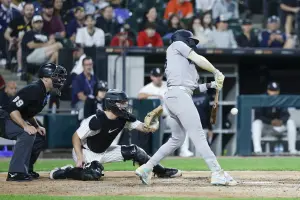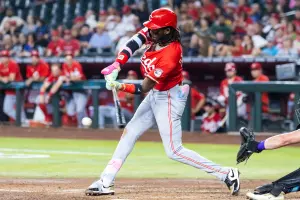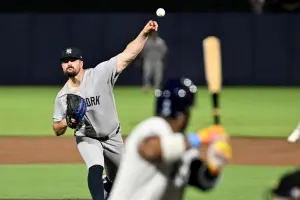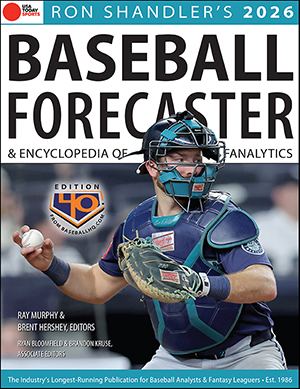
(*) F/F SPOTLIGHT: Charlie Blackmon
Charlie Blackmon (OF, COL) quickly became a household name in 2014 thanks to a scorching performance over the season's first month (.389 BA, five HR, seven SB). Blackmon, who had relatively little MLB success at the time, was logically tabbed as a regression candidate the rest of the way. While he fell back a bit in the second half, Blackmon still put together a $30 season in standard 5x5 formats.
Blackmon has built upon that success in 2015 with an even better performance—he’s been one of the most productive outfielders in the game. This week, we deep dive into Blackmon’s profile to see how he’s been able to do it, and more importantly, if he can hold this status as a top OF moving forward.
A checkered minor league history
Drafted in the second round of the 2008 amateur draft out of Georgia Tech, Blackmon has been in Colorado's organization throughout his entire professional career. He spent more than five years in Colorado’s minor league system, mostly in the higher levels, with mixed results:
Year Age Level AB BA bb% ct% Eye PX Spd HR/SB BPV ==== === ===== === ==== === === ==== === === ===== === 2010 24 aa 337 .271 7 90 0.72 107 113 10/14 95 2011 25 aaa 243 .259 4 84 0.24 100 108 6/ 6 57 2012 26 aaa 228 .246 7 79 0.36 95 129 3/ 6 47 2013 27 aaa 257 .226 7 82 0.40 70 112 2/ 4 32
After a promising performance at Double-A Tulsa in 2010, Blackmon’s skills gradually declined over three seasons at Triple-A. He maintained solid overall plate skills and speed throughout, but a steady drop in power numbers hurt his overall outlook as a prospect. An excerpt from our last call-up report, which tagged Blackmon with an 8D prospect rating in August 2012:
"He [Blackmon] is an exciting and aggressive player who makes outstanding contact with a short, simple stroke from the left side. While he has good strength, his lack of premium bat speed may limit his power potential in the big leagues. As he rarely strikes out and he knows how to read pitches, he should maintain a fairly high BA. Blackmon has above average speed and sound instincts while on base. With his hitting ability and patient approach, he should get stolen base opportunities.”
2014's breakout
Entering the 2014 season, Blackmon was battling teammate Corey Dickerson (OF, COL) for the starting gig in center field. Though Dickerson had the better prospect outlook at the time, Blackmon won the Opening Day job thanks to an impressive spring training.
The move came with somewhat little fanfare given Blackmon’s minor league history, but that quickly changed after his breakout April performance. Blackmon put up a .297 BA with 12 HR and 15 SB in 2014’s first half, and while he came back to earth down the stretch, the overall numbers qualified as a wildly successful season on the surface.
Year AB BA xBA bb% ct% h% PX xPX GB/LD/FB hr/f Spd SBO HR/SB BPV ===== === ==== ==== === === == === === ======== ==== === === ===== === 14-1H 310 .297 .283 5 87 31 105 89 45/19/36 12% 89 23% 12/15 73 14-2H 282 .280 .253 4 80 33 92 96 37/25/38 8% 117 27% 7/13 39
Though Blackmon managed to hold it together, his 2H fade left reason for doubt:
- Blackmon’s plate skills dipped dramatically in the second half—he struck out far more frequently as the season went on.
- Blackmon’s 2H PX and hr/f fell to below league-average levels, which his underlying xPX suggested was the case all year long.
- His post-July xBA questioned whether he’d be able to keep up the lofty surface BA in 2015.
Outside of his speed metrics, Blackmon’s skills dropped across the board in the second half, which left many skeptical of a repeat. This included the 2015 Baseball Forecaster, which noted that he was "Unlikely to repeat. DOWN: 10-45-.260, 15 SB."
No slowing down in 2015
Rather than slowing down, Blackmon’s .293 BA and 13 HR / 29 SB so far in 2015 show that he's kept his foot on the gas. He's currently enjoying an even better year in his second full season. Do the skills agree?
Year AB BA xBA bb% ct% HctX h% PX xPX GB/LD/FB hr/f Spd SBO HR/SB ==== === ==== ==== === === ==== == === === ======== ==== === === ===== 2014 593 .288 .269 5 84 103 32 100 94 41/22/37 10% 101 25% 19/28 2015 409 .293 .273 8 80 123 34 112 136 41/24/35 11% 121 34% 13/29
Some fundamental changes in Blackmon’s approach have worked wonders in 2015:
- Blackmon has taken a more patient approach at the plate. While his ct% hasn’t improved from 2014’s 2H, noteworthy gains in LD% and HctX suggest his current BA could stick.
- Despite a low FB%, Blackmon has built upon 2014’s power skills—an excellent xPX suggests there’s room for even more growth.
- Spd has increased and he’s been given complete freedom on the basepaths. The career-high SB total shows he’s taking full advantage.
Blackmon appears to be more patient at the plate in 2015, and he’s producing hard-hit balls at a much higher rate. The results can be seen across many of his key metrics (xBA, HctX, xPX), which provide a solid BA and HR foundation in addition to his already-excellent speed. It’s worth digging deeper into Blackmon’s plate approach to see how he’s made these gains in his second full season.
Plate discipline metrics
Before we dive in, here’s a quick refresher on some key plate control metrics we’ll use in this analysis (data and definitions used from fangraphs.com):
Z-Swing%: Percentage of pitches a batter swings at inside the strike zone. (League average is 66.9%)
O-Swing%: Percentage of pitches a batter swings at outside the strike zone. (31.2%)
Z-Contact%:: Percentage of times a batter makes contact with the ball when swinging at pitches inside the strike zone. (86.9%)
O-Contact%: Percentage of times a batter makes contact with the ball when swinging at pitches outside the strike zone. (65.2%)
SwStr%: Swinging strike percentage. (9.8%)
Blackmon's plate control trends over the last three seasons confirm there’s been a major shift in his approach:
Year Z-Swing% O-Swing% Z-Contact% O-Contact% SwStr% ==== ======== ======== ========== ========== ====== 2013 68.6 37.8 91.0 71.7 8.7 2014 70.1 39.0 92.6 75.4 7.5 2015 60.1 27.2 92.4 70.5 6.4
For the visual learners, here’s Blackmon’s Swing% (percentage of pitches a batter swings at) by zone in 2014, courtesy of brooksbaseball.net:
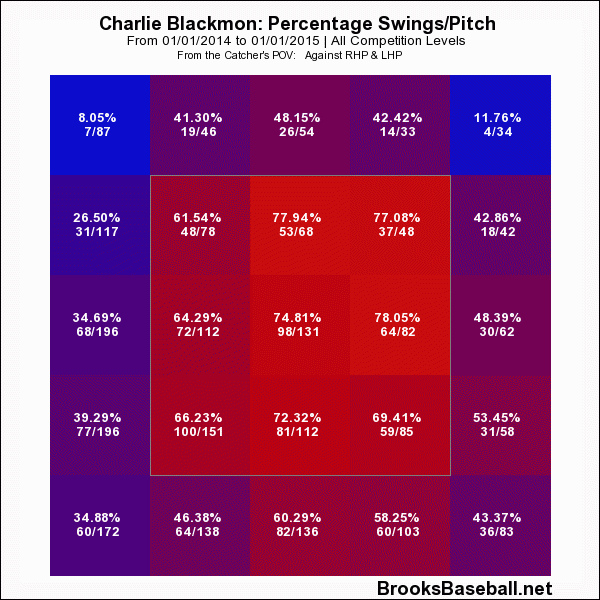
And in 2015, we can see that Blackmon has offered at fewer pitches throughout almost all of the hitting zones:
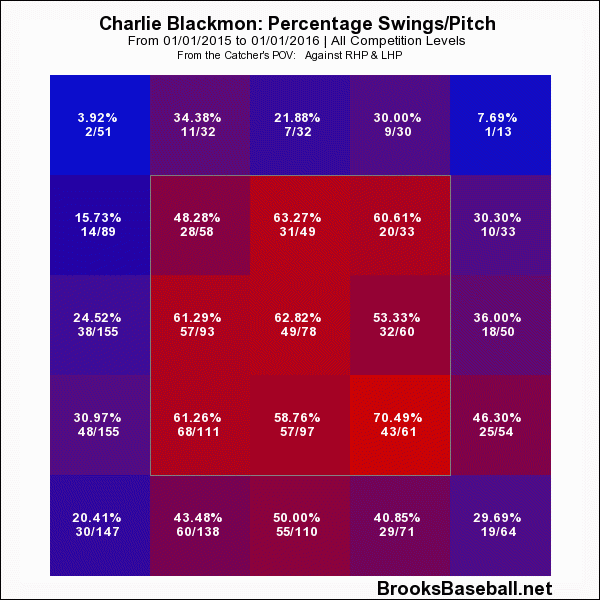
We see considerable drops in both Z-Swing% and O-Swing%, which hints that Blackmon has been a much more selective hitter in 2015. A similar fall in SwStr% supports this theory as well.
However, Blackmon’s lack of aggressiveness can also be a double-edged sword. The dip in Z-Swing% could be causing his ct% to fall, as he’s taking more pitches in the zone for strikes. However, he’s also hacking at fewer pitches outside the zone, and it’s typically better to see the ct% dip caused by fewer swings rather than an increase in whiffs—his contact rate at balls in the zone (Z-Contact%) is in line with 2014.
Batted balls and heat maps
In addition to the plate discipline shifts noted above, Blackmon has also shown some interesting changes to his batted ball profile. We noted earlier in this piece that Blackmon has made strides making more hard contact (HctX) and hitting more line drives, but he’s also getting out in front and pulling the ball more often in 2015. The following heat map (courtesy of baseballsavant.com) compares Blackmon’s batted ball locations from 2014 to 2015:
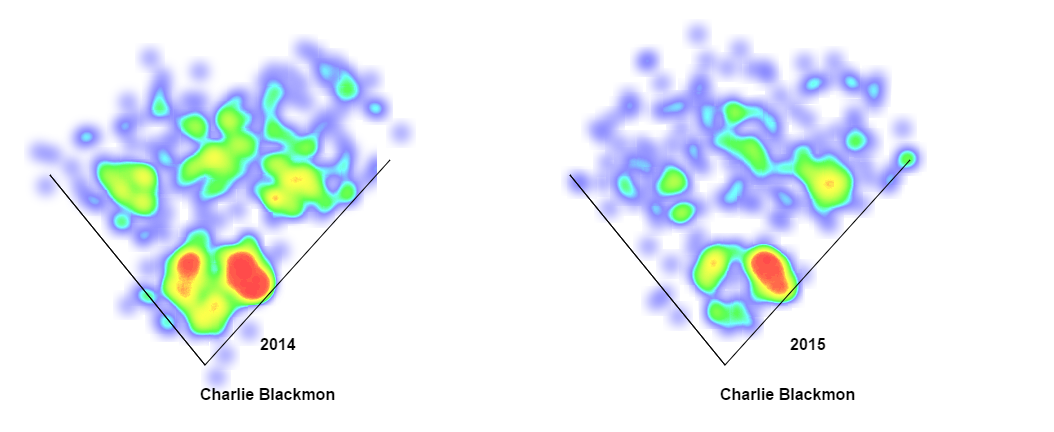
We also compare some of Blackmon’s key batted ball metrics below, where ‘Pull%’ is the percentage of pulled balls over all balls put in play (league average is near 40%):
Year HH% LD% Pull% ==== === === ===== 2014 28 22 41.2 2015 35 24 45.7
While an increase in Pull% alone doesn’t necessarily mean more success—hitters who spray the ball to all fields are cool too—Blackmon's ability to pull the ball could very well be driving the higher hard-hit ball rate (HH%). When we combine this with the LD% gains, there's suddenly a lot to like here.
MLB clubs are certainly aware of Blackmon’s pull tendencies and have started to shift against him, but this hasn't yet affected his h%. Line drives and hard-hit balls are a great way to trump defensive positioning. Simply put, Blackmon's impressive batted ball profile supports his overall BA and HR output.
The Coors effect?
As with most successful hitters who don the Rockies uniform, especially left-handers like Blackmon, it’s worth checking in on some home/away splits to see how much Coors Field has padded his numbers to date:
Venue AB BA/OBP/SLG bb% ct% Eye h% HR ===== === ============== === === ==== == == Home 223 .323/.383/.471 7 87 0.56 36 4 Away 213 .258/.333/.468 8 74 0.33 30 9
And the same exercise for LHP/RHP:
Hand AB BA/OBP/SLG bb% ct% Eye h% HR ===== === ============== === === ==== == == vLHP 107 .234/.293/.349 6 79 0.32 28 2 vRHP 302 .315/.383/.513 8 80 0.46 36 11
In news that shouldn't be classified as shocking, Blackmon has been a better overall hitter at Coors Field and against right-handed pitching, but there a few positives to take away here:
- Though his ct% has slipped on the road, Blackmon’s power numbers have been fine away from Coors Field. He’s hit nine of 13 HR on the road this season.
- His LHP/RHP splits are a bit more pronounced, though a 28% h% against southpaws has hurt his BA. His ct% between the two is nearly identical.
- Lefties have sapped Blackmon’s power, which could be the Achilles heel here. He has just a 74 PX vs. LHP this season (125 PX vs. RHP).
Blackmon is showing that he’s not necessarily a liability away from Coors Field, and though his LHP/RHP splits are a bit more severe, they haven’t yet cost him regular playing time. His plate skills vs. LHP check out OK, and while the lack of power against lefties is worth monitoring, we wouldn't raise any major red flags at this point.
Conclusion
Many thought 2014 was the career year for Charlie Blackmon, especially given his 2H slide after such a hot start. Instead of falling from that peak, some fundamental shifts in Blackmon's approach have enabled him to push the envelope in 2015. Blackmon is being a much more selective hitter by swinging at fewer pitches throughout the zone. When he does swing, several good things are happening: he's pulling the ball more often, producing more hard-hit balls, and hitting a healthy dose of line drives.
These changes certainly give Blackmon some long-term staying power. The foundation is there for a strong BA, his speed and willingness to run will let him rack up SB, and the underlying power skills suggest there’s some HR upside as well. Blackmon is on pace for his second straight $30+ season, and the promising adjustments he’s made in 2015 say this is a level he can maintain for the foreseeable future.


